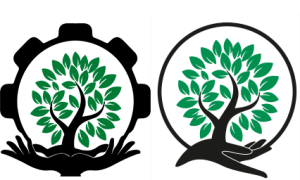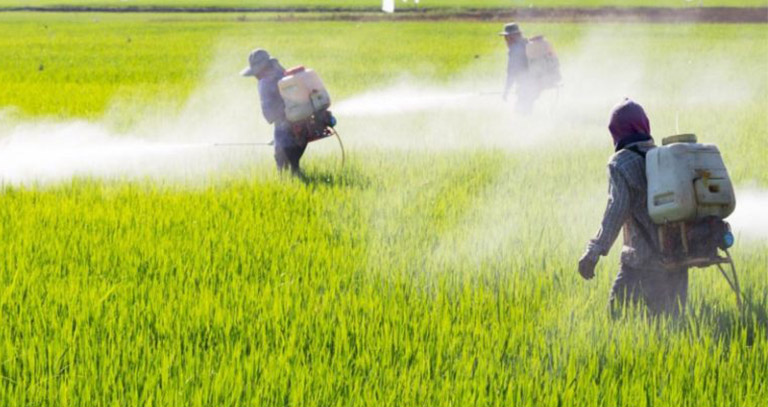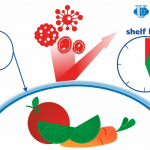Hazards of Chemical Pesticides
Pesticides are substances or mixtures of substances that are mainly used in agriculture or in public health protection programs in order to protect plants from pests, weeds or diseases, and humans from vector-borne diseases, such as malaria, dengue fever, and schistosomiasis. Insecticides, fungicides, herbicides, rodenticides, and plant growth regulators are typical examples
Pesticide use raises a number of environmental concerns, including human and animal health hazards. Food contaminated with toxic pesticides is associated with severe effects on the human health, because it is the basic necessity of life. Over 98% of sprayed insecticides and 95% of herbicides reach a destination other than their target species, including non-target species, air, water and soil. Pesticide toxicity can result from ingestion, inhalation or dermal absorption. Continued exposure to these chemicals for a long period may result in various diseases some of which are listed below
Neurological, psychological and behavioral dysfunctions
Hormonal imbalances, leading to infertility, breast pain
Іmmune system dysfunction
Reproductive system defects
Cancers
Genotoxicity
Blood disorders
Pesticides can contaminate soil, water, turf, and other vegetation. In addition to killing insects or weeds, pesticides can be toxic to a host of other organisms including birds, fish, beneficial insects, and non-target plants. Recent articles and reports review toxicological and epidemiological evidences for various health effects associated with pesticides. Extensive toxicological studies in animals demonstrate that a number of pesticides to which the general population may be chronically exposed are potential carcinogens, neurotoxins, reproductive toxins, and immunotoxins. Gonzalez with colleagues showed DNA damages under 2,4-D exposure in Chinese Hamster ovary cells (CHO). There are evidences on involvement of pesticides in development of neurodegenerative diseases. Many scientists reported impact of pesticides on biochemical parameters, in particular on protein metabolism, endocrine , and reproductive systems. Pesticide contamination of both surface and ground waters can affect aquatic fauna and flora, as well as human health when water is used for public consumption. Aquatic organisms are directly exposed to chemicals resulting from agricultural production via surface run-off or indirectly through trophic chains
Pesticide Alternatives
In fact, modern agricultural business leads to environmental crisis. Excessive use of pesticides and to increase the food production may result in serious environmental “diseases”. They may be grouped into two sets
Diseases of ecotopes (erosion, loss of soil fertility, depletion of nutrient reserves, salinization and alkalinization, pollution of water systems
Diseases of biocoenosis (loss of crop, wild plant, and animal genetic resources, elimination of natural enemies, pest resurgence and genetic resistance to pesticides, chemical contamination, and destruction of natural control mechanisms
Due to this and many other reasons, search for “safest” analogue pesticides of natural origin is for one of the most important problems of our civilization. Potential alternatives to pesticides are available and include specific methods of plant cultivation, use of biological pest controls (such as pheromones and microbial pesticides), plant genetic engineering, and methods of interfering with insect breeding. Application of composted yard waste has also been used as a way of controlling pests. The major alternatives to traditional chemical pesticides are listed below
Natural pesticides
Biological pest control
Plant genetic engineering
Interfering with insect breeding
Application of composted yard waste
Cultivation practices
Release of organisms that fight the pests
Interfering with insects’ reproduction
Soil steaming
These methods become increasingly popular and usually are safer than traditional chemical pesticides. The polyculture (growing multiple types of plants together), crop rotation, planting crops in areas where the pests that damage them do not live and use of trap crops that attract pests away from the real crop are elements of cultivation practices. Another example of an alternative to pesticide is using of other organisms that
fight the pest. These organisms can include natural predators or parasites of the pests
Ref
Maksymiv, I. (2015). Pesticides: benefits and hazards. Journal of Vasyl Stefanyk Precarpathian National University, 2(1), 70-76
Nicolopoulou-Stamati, P., Maipas, S., Kotampasi, C., Stamatis, P., & Hens, L. (2016). Chemical pesticides and human health: the urgent need for a new concept in agriculture. Frontiers in public health, 4, 148
This post is also available in: Persian




Leave a Reply
Want to join the discussion?Feel free to contribute!